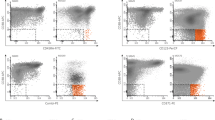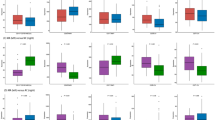Abstract
Occurrence of phenotypic abnormalities in CD34+ hematopoietic progenitor and precursor cells (HPC) and their major B-cell and nonlymphoid compartments has been frequently reported in myelodysplastic syndromes (MDS). Here, we analyze for the first time the numerical and phenotypic abnormalities of different maturation-associated subsets of bone marrow (BM) CD34+ HPC from 50 newly diagnosed MDS patients in comparison to normal/reactive BM (n=29). Our results confirm the existence of heterogeneously altered phenotypes among CD34+ HPC from MDS and indicate that such variability depends both on the relative distribution of the different subsets of CD34+ HPC committed into the different myeloid and B-lymphoid compartments, and their immunophenotype (for example, higher reactivity for CD117 and CD13 and lower expression of CyMPO, CD64 and CD65 on CD34+ immature and neutrophil precursors), a clear association existing between the accumulation of CD34+ HPC and that of immature CD34+ HPC. Interestingly, expansion of erythroid- and neutrophil-lineage CD34+ cells is detected in low-grade MDS at the expense of CD34+ plasmacytoid dendritic cell and B-cell precursors, while expansion of immature CD34+ precursors occurs in high-grade MDS. On the basis of the number and severity of the phenotypic abnormalities detected, a scoring system is proposed that efficiently discriminates between normal/reactive and MDS CD34+ HPC, the mean score significantly increasing from low- to high-grade MDS.
This is a preview of subscription content, access via your institution
Access options
Subscribe to this journal
Receive 12 print issues and online access
$259.00 per year
only $21.58 per issue
Buy this article
- Purchase on Springer Link
- Instant access to full article PDF
Prices may be subject to local taxes which are calculated during checkout



Similar content being viewed by others
References
Mufti GJ . Pathobiology, classification, and diagnosis of myelodysplastic syndrome. Best Pract Res Clin Haematol 2004; 17: 543–557.
Ribeiro E, Lima CS, Metze K, Lorand-Metze I . Flow cytometric analysis of the expression of Fas/Fasl in bone marrow CD34+ cells in myelodysplastic syndromes: relation to disease progression. Leuk Lymphoma 2004; 45: 309–313.
Parker JE, Mufti GJ, Rasool F, Mijovic A, Devereux S, Pagliuca A . The role of apoptosis, proliferation, and the Bcl-2-related proteins in the myelodysplastic syndromes and acute myeloid leukemia secondary to MDS. Blood 2000; 96: 3932–3938.
Kussick SJ, Fromm JR, Rossini A, Li Y, Chang A, Norwood TH et al. Four-color flow cytometry shows strong concordance with bone marrow morphology and cytogenetics in the evaluation for myelodysplasia. Am J Clin Pathol 2005; 124: 170–181.
Liesveld JL, Jordan CT, Phillips GL . The hematopoietic stem cell in myelodysplasia. Stem Cells 2004; 22: 590–599.
Fey M . Normal and malignant hematopoiesis. Ann Oncol 2007; 18 (Suppl 1): i9–i13.
Fuchigami K, Mori H, Matsuo T, Iwanaga M, Nagai K, Kuriyama K et al. Absolute number of circulating CD34+ cells is abnormally low in refractory anemias and extremely high in RAEB and RAEB-t; novel pathologic features of myelodysplastic syndromes identified by highly sensitive flow cytometry. Leuk Res 2000; 24: 163–174.
Ogata K, Kishikawa Y, Satoh C, Tamura H, Dan K, Hayashi A . Diagnostic application of flow cytometric characteristics of CD34+ cells in low-grade myelodysplastic syndromes. Blood 2006; 108: 1037–1044.
Ogata K, Nakamura K, Yokose N, Tamura H, Tachibana M, Taniguchi O et al. Clinical significance of phenotypic features of blasts in patients with myelodysplastic syndrome. Blood 2002; 100: 3887–3896.
Orfao A, Ortuno F, de Santiago M, Lopez A, San Miguel J . Immunophenotyping of acute leukemias and myelodysplastic syndromes. Cytometry A 2004; 58: 62–71.
del Canizo MC, Fernandez ME, Lopez A, Vidriales B, Villaron E, Arroyo JL et al. Immunophenotypic analysis of myelodysplastic syndromes. Haematologica 2003; 88: 402–407.
Pirruccello SJ, Young KH, Aoun P . Myeloblast phenotypic changes in myelodysplasia. CD34 and CD117 expression abnormalities are common. Am J Clin Pathol 2006; 125: 884–894.
Arroyo JL, Fernandez ME, Hernandez JM, Orfao A, San Miguel JF, del Canizo MC . Impact of immunophenotype on prognosis of patients with myelodysplastic syndromes. Its value in patients without karyotypic abnormalities. Hematol J 2004; 5: 227–233.
Wells DA, Benesch M, Loken MR, Vallejo C, Myerson D, Leisenring WM et al. Myeloid and monocytic dyspoiesis as determined by flow cytometric scoring in myelodysplastic syndrome correlates with the IPSS and with outcome after hematopoietic stem cell transplantation. Blood 2003; 102: 394–403.
Monreal MB, Pardo ML, Pavlovsky MA, Fernandez I, Corrado CS, Giere I et al. Increased immature hematopoietic progenitor cells CD34+/CD38dim in myelodysplasia. Cytometry B Clin Cytom 2006; 70: 63–70.
Maynadie M, Picard F, Husson B, Chatelain B, Cornet Y, Le Roux G et al. Immunophenotypic clustering of myelodysplastic syndromes. Blood 2002; 100: 2349–2356.
Jaffe ES, Harris NL, Stein H, Vardiman JW . Pathology and Genetics of Tumours of the Hematopoietic and Lymphoid Tissues. Lyon, France: IARC Press, 2001, 20. World Health Organization Classification of Tumours.
Vardiman JW, Harris NL, Brunning RD . The World Health Organization (WHO) classification of the myeloid neoplasms. Blood 2002; 100: 2292–2302.
Greenberg P, Cox C, LeBeau MM, Fenaux P, Morel P, Sanz G et al. International scoring system for evaluating prognosis in myelodysplastic syndromes. Blood 1997; 89: 2079–2088.
Almeida J, Bueno C, Alguero MC, Sanchez ML, Canizo MC, Fernandez ME et al. Extensive characterization of the immunophenotype and pattern of cytokine production by distinct subpopulations of normal human peripheral blood MHC II+/lineage-cells. Clin Exp Immunol 1999; 118: 392–401.
Kappelmayer J, Gratama JW, Karaszi E, Menendez P, Ciudad J, Rivas R et al. Flow cytometric detection of intracellular myeloperoxidase, CD3 and CD79a. Interaction between monoclonal antibody clones, fluorochromes and sample preparation protocols. J Immunol Methods 2000; 242: 53–65.
Hernandez-Campo PM, Almeida J, Matarraz S, de Santiago M, Sanchez ML, Orfao A . Quantitative analysis of the expression of glycosylphosphatidylinositol-anchored proteins during the maturation of different hematopoietic cell compartments of normal bone marrow. Cytometry B Clin Cytom 2007; 72: 34–42.
Primo D, Sanchez ML, Espinosa AB, Tabernero MD, Rasillo A, Sayagues JM et al. Lineage involvement in chronic myeloid leukaemia: comparison between MBCR/ABL and mBCR/ABL cases. Br J Haematol 2006; 132: 736–739.
Martín-Martín L, Almeida J, Orfao A . Phenotypic characterization of plasmacytoid dendritic cells lineage maturation pathway in normal adult bone marrow: a frame of reference for understanding dendritic cell malignancies. Haematologica 2006; 91: 159–160. Abstract Book.
Sutherland DR, Anderson L, Keeney M, Nayar R, Chin-Yee I . The ISHAGE guidelines for CD34+ cell determination by flow cytometry. International Society of Hematotherapy and Graft Engineering. J Hematother 1996; 5: 213–226.
Schwartz A, Fernandez RE, Vogt R, Gratama JW . Standardizing flow cytometry: construction of a standardized fluorescence calibration plot using matching spectral calibrators. Cytometry 1996; 26: 22–31.
Alimena G, Billstrom R, Casalone R, Gallo E, Mitelman F, Pasquali F . Cytogenetic pattern in leukemic cells of patients with constitutional chromosome anomalies. Cancer Genet Cytogenet 1985; 16: 207–218.
Mitelman F . Neoplasia. In: ISCN An International System for Human Cytogenetic Nomenclature. Basel: S. Karger, 1995, p 78.
Ketterling RP, Wyatt WA, VanWier SA, Law M, Hodnefield JM, Hanson CA et al. Primary myelodysplastic syndrome with normal cytogenetics: utility of ‘FISH panel testing’ and M-FISH. Leuk Res 2002; 26: 235–240.
Tibshirani R, Hastie T, Narasimhan B, Chu G . Diagnosis of multiple cancer types by shrunken centroids of gene expression. Proc Natl Acad Sci USA 2002; 99: 6567–6572.
Benesch M, Deeg HJ, Wells D, Loken M . Flow cytometry for diagnosis and assessment of prognosis in patients with myelodysplastic syndromes. Hematology 2004; 9: 171–177.
Stetler-Stevenson M, Arthur DC, Jabbour N, Xie XY, Molldrem J, Barrett AJ et al. Diagnostic utility of flow cytometric immunophenotyping in myelodysplastic syndrome. Blood 2001; 98: 979–987.
Valent P, Horny HP, Bennett JM, Fonatsch C, Germing U, Greenberg P et al. Definitions and standards in the diagnosis and treatment of the myelodysplastic syndromes: consensus statements and report from a working conference. Leuk Res 2007; 31: 727–736.
Bene MC, Feuillard J, Bernard H MM . Immunophenotyping of myelodysplasia. Clin Appl Immunol Rev 2005; 5: 133–148.
Ribeiro E, Matarraz S, de Santiago M, Lima CS, Metze K, Giralt M et al. Maturation-associated immunophenotypic abnormalities in bone marrow B-lymphocytes in myelodysplastic syndromes. Leuk Res 2006; 30: 9–16.
Lorand-Metze I, Ribeiro E, Lima CS, Saad ST, Metze K . Bone marrow B and T lymphocytes present selective changes in myelodysplastic syndromes. Haematol J 2004; Suppl 2: S245.
Hofmann WK, de Vos S, Komor M, Hoelzer D, Wachsman W, Koeffler HP . Characterization of gene expression of CD34+ cells from normal and myelodysplastic bone marrow. Blood 2002; 100: 3553–3560.
Sparrow RL, O'Flaherty E, Blanksby TM, Szer J, Van der Weyden MB . Perturbation in the ability of bone marrow stroma from patients with acute myeloid leukemia but not chronic myeloid leukemia to support normal early hematopoietic progenitor cells. Leuk Res 1997; 21: 29–36.
Mayani H . Composition and function of the hemopoietic microenvironment in human myeloid leukemia. Leukemia 1996; 10: 1041–1047.
Jilani I, Estey E, Huh Y, Joe Y, Manshouri T, Yared M et al. Differences in CD33 intensity between various myeloid neoplasms. Am J Clin Pathol 2002; 118: 560–566.
Mishima Y, Matsumoto-Mishima Y, Terui Y, Katsuyama M, Yamada M, Mori M et al. Leukemic cell-surface CD13/aminopeptidase N and resistance to apoptosis mediated by endothelial cells. J Natl Cancer Inst 2002; 94: 1020–1028.
Boultwood J, Wainscoat JS . Clonality in the myelodysplastic syndromes. Int J Hematol 2001; 73: 411–415.
Acknowledgements
This work has been partially supported by the following grants: RTICC RD06/0020/0035 from the Instituto de Salud Carlos III, Ministerio de Sanidad y Consumo, Madrid, Spain. JMS is supported by a grant from Ministerio de Sanidad y Consumo (CP05/00321) and PHC is supported by a grant from the European Commission (MSCNet contract no. 037602).
Author information
Authors and Affiliations
Corresponding author
Additional information
Supplementary Information accompanies the paper on the Leukemia website (http://www.nature.com/leu)
Supplementary information
Rights and permissions
About this article
Cite this article
Matarraz, S., López, A., Barrena, S. et al. The immunophenotype of different immature, myeloid and B-cell lineage-committed CD34+ hematopoietic cells allows discrimination between normal/reactive and myelodysplastic syndrome precursors. Leukemia 22, 1175–1183 (2008). https://doi.org/10.1038/leu.2008.49
Received:
Revised:
Accepted:
Published:
Issue Date:
DOI: https://doi.org/10.1038/leu.2008.49
Keywords
This article is cited by
-
The twilight zone: plasticity and mixed ontogeny of neutrophil and eosinophil granulocyte subsets
Seminars in Immunopathology (2021)
-
A pilot study on the usefulness of peripheral blood flow cytometry for the diagnosis of lower risk myelodysplastic syndromes: the “MDS thermometer”
BMC Hematology (2018)
-
Sensitivity of hematopoietic stem cells to mitochondrial dysfunction by SdhD gene deletion
Cell Death & Disease (2016)
-
Improving the differential diagnosis between myelodysplastic syndromes and reactive peripheral cytopenias by multiparametric flow cytometry: the role of B-cell precursors
Diagnostic Pathology (2015)
-
KIT mutation analysis in mast cell neoplasms: recommendations of the European Competence Network on Mastocytosis
Leukemia (2015)



